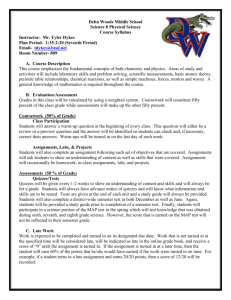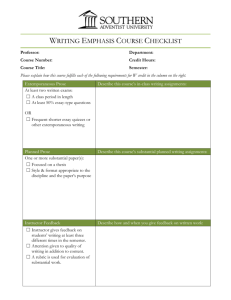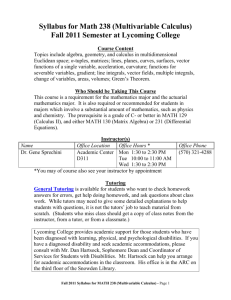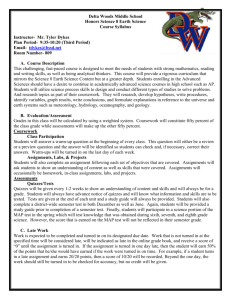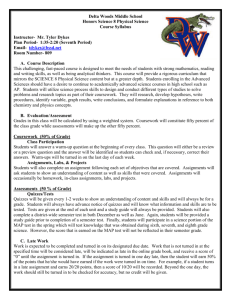Math 106 * Section #1
advertisement
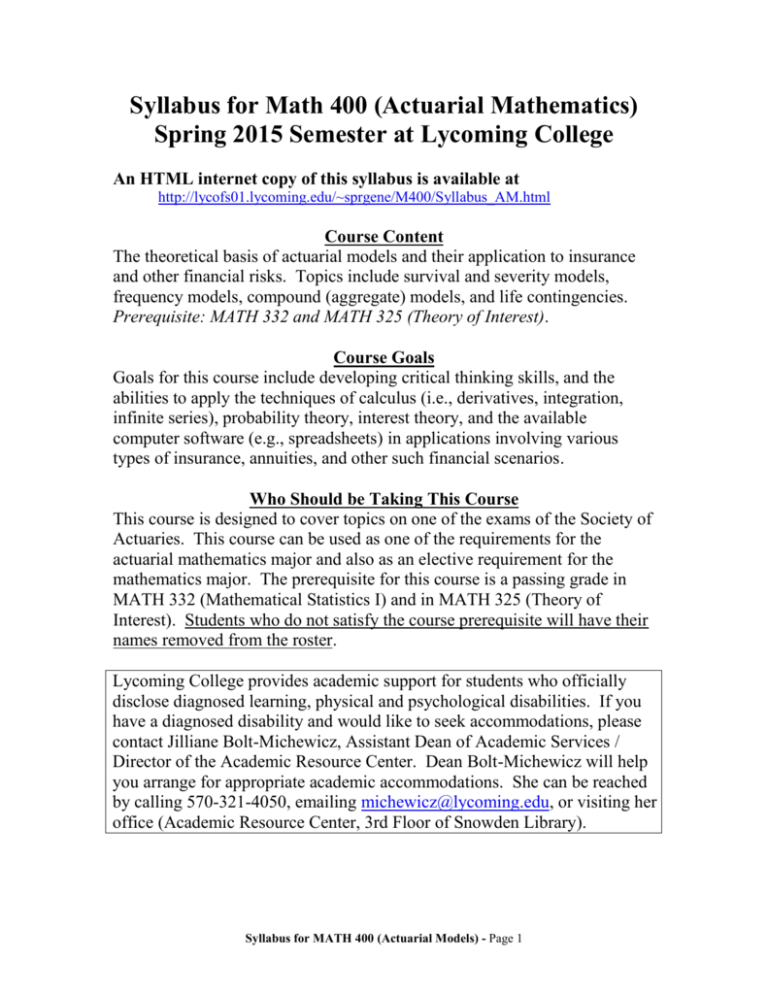
Syllabus for Math 400 (Actuarial Mathematics) Spring 2015 Semester at Lycoming College An HTML internet copy of this syllabus is available at http://lycofs01.lycoming.edu/~sprgene/M400/Syllabus_AM.html Course Content The theoretical basis of actuarial models and their application to insurance and other financial risks. Topics include survival and severity models, frequency models, compound (aggregate) models, and life contingencies. Prerequisite: MATH 332 and MATH 325 (Theory of Interest). Course Goals Goals for this course include developing critical thinking skills, and the abilities to apply the techniques of calculus (i.e., derivatives, integration, infinite series), probability theory, interest theory, and the available computer software (e.g., spreadsheets) in applications involving various types of insurance, annuities, and other such financial scenarios. Who Should be Taking This Course This course is designed to cover topics on one of the exams of the Society of Actuaries. This course can be used as one of the requirements for the actuarial mathematics major and also as an elective requirement for the mathematics major. The prerequisite for this course is a passing grade in MATH 332 (Mathematical Statistics I) and in MATH 325 (Theory of Interest). Students who do not satisfy the course prerequisite will have their names removed from the roster. Lycoming College provides academic support for students who officially disclose diagnosed learning, physical and psychological disabilities. If you have a diagnosed disability and would like to seek accommodations, please contact Jilliane Bolt-Michewicz, Assistant Dean of Academic Services / Director of the Academic Resource Center. Dean Bolt-Michewicz will help you arrange for appropriate academic accommodations. She can be reached by calling 570-321-4050, emailing michewicz@lycoming.edu, or visiting her office (Academic Resource Center, 3rd Floor of Snowden Library). Syllabus for MATH 400 (Actuarial Models) - Page 1 Instructor(s) Name Office Location Office Hours * Dr. Gene Academic Mon 10:30 AM to 11:15 AM Sprechini Center D311 Tue 8:45 AM to 9:30 AM Wed 10:30 AM to 11:15 AM Fri 10:30 AM to 11:15 AM *You may of course also see your instructor by appointment Office Phone (570) 321-4288 Tutoring General Tutoring is not available this semester. Required Materials Each student must have a copy of the textbook: Models for Quantifying Risk by Stephen J. Camilli, Ian Duncan, and Richard L. London, 6th edition, 2014, ACTEX Publications (ISBN# 978-1-62542-347-4) a three-ring binder containing copy of this syllabus, the course schedule, class notes, completed assignments, etc. (Note: Since students will need to use this binder every day in class and will be allowed to use this binder for exams, the binders should be kept up-to-date and complete.) a TI-84 calculator or a financial calculator is highly recommended (but other calculators may be satisfactory) a computer account on the college network in order to access Excel Course Links Course Schedule Some Well-Known Sums and Series Interest Solver Excel Spreadsheet Syllabus for MATH 400 (Actuarial Models) - Page 2 Grading Item Point Values and Policies Homework Homework assignments are usually announced at the end of each class; the assignment due for the following class is posted in red on the course schedule. The total number of possible homework points for the semester will be between 600 and 800. Late homework is never accepted for any reason. If within 24 hours a student gives a legitimate reason (as judged by the instructor) for not submitting an assignment on time, an alternative assignment and due date will be given to allow student to earn the missed points; homework assignments not submitted should be completed for practice and answers checked with a tutor or the instructor. A student who misses submitting more than 10 homework assignments automatically fails the course. Semester Four semester tests are given, one about every three or four weeks; specific Tests dates are available from the course schedule. Each semester test is worth 150 points, so that the total number of possible test points for the semester is 600. For each missed test, a grade of zero is recorded, unless (1) the instructor is presented with documented evidence of a medical reason for not completing the test at the scheduled time, and (2) arrangements to make up the test are made within 24 hours of the originally scheduled exam time. While each test covers primarily the course material for the two or three weeks prior to the test, test questions may come from any previously covered material (i.e., each test could be considered cumulative). Final Exam The final exam (administered during final exam week) is worth 200 points. Attendance The final course grade percentage is reduced by 4% for each unexcused absence after the third unexcused absence; an absence is considered to be excused when the instructor accepts an email from the student explaining the reason for the absence. It is the student’s responsibility to find out what was missed in class and keep up with the coursework. Students can get a copy of class notes from the instructor, from a tutor, or from a classmate. A student with more than 10 unexcused absences automatically fails the course. Between 1400 and 1600 total points can be earned. The course letter grade is determined from the percentage of points earned out of the total number of possible points as follows: A = above 93.33% A– = 90% to 93.33% B+ = 86.67% to 90% B = 83.33% to 86.67% B– = 80% to 83.33% C+ = 76.67% to 80% C = 73.33% to 76.67% C– = 70% to 73.33% D+ = 66.67% to 70% D = 63.33% to 66.67% D– = 60% to 63.33% F = below 60% Syllabus for MATH 400 (Actuarial Models) - Page 3 Tips for Success in This Course (1) Keep up with the homework - understanding every homework assignment as completely as you can is the key to grasping the course material. Even though there will be some homework assignments that you may not be required to submit, do them anyway, since they will help you master the material. Check all your homework answers with a tutor before submitting an assignment. (2) As part of your preparation for tests and the final exam, do all exercises suggested for practice by the instructor, and start working on these early; don't wait for the night before the test or exam. (3) Get your questions answered quickly by the tutor, the course instructor, or a classmate. (4) Keep your binder up-to-date and well-organized. General Standards and Policies All work submitted must be of professional quality. All paper must be neat, without ragged edges, rips, tears, smudges, stains, etc. All answers must be clear, complete, and concise; handwriting must be legible. If the instructor can't read it, it's wrong. Assignments may be down-graded if these standards are not met. It can be very helpful for some students to work together on daily assignments and to study together; this is encouraged when it does not result in one student simply copying another's work with no understanding. Acts of academic dishonesty will result in a grade of F for the course, and a letter to the Provost describing the circumstances. If you are having problems in the course, talk to the instructor; don't involve yourself in academic dishonesty. With each assignment submitted, students are expected to write a short note at the end of the assignment indicating from whom help was received and to whom help was given (but this does not affect the grade for the assignment). The following is from the FACULTY HANDBOOK in the section titled Student Course Load: "It is expected that students will spend, in preparation for courses, two hours of study time outside the classroom for every hour of credit in the classroom." This means that you should be prepared to spend, on average, eight hours per week outside of class working on a four-credit course; however, this will vary from student to student and from course to course. Your time will be Syllabus for MATH 400 (Actuarial Models) - Page 4 spent reading the text, reviewing class notes, and completing homework exercises. If you encounter a problem while working on assignments, do not spend more than 20 or 30 minutes trying to solve the problem; if you cannot solve a problem in 20 or 30 minutes, even with the help of a tutor or classmate, work on something else and show the problem to the instructor of the course as soon as possible. Syllabus for MATH 400 (Actuarial Models) - Page 5


